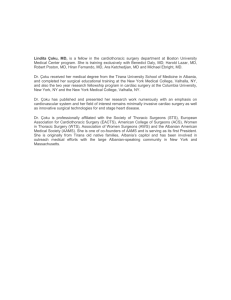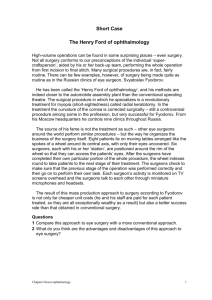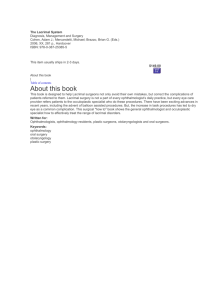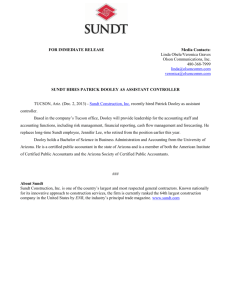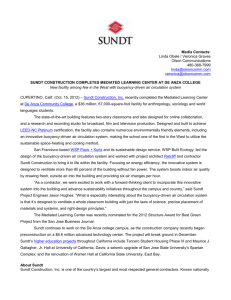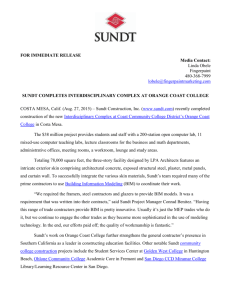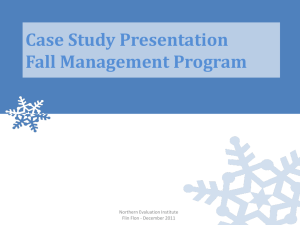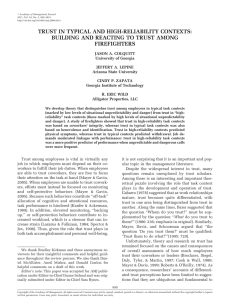Research Articles Related to Medical Care and High Reliability
advertisement
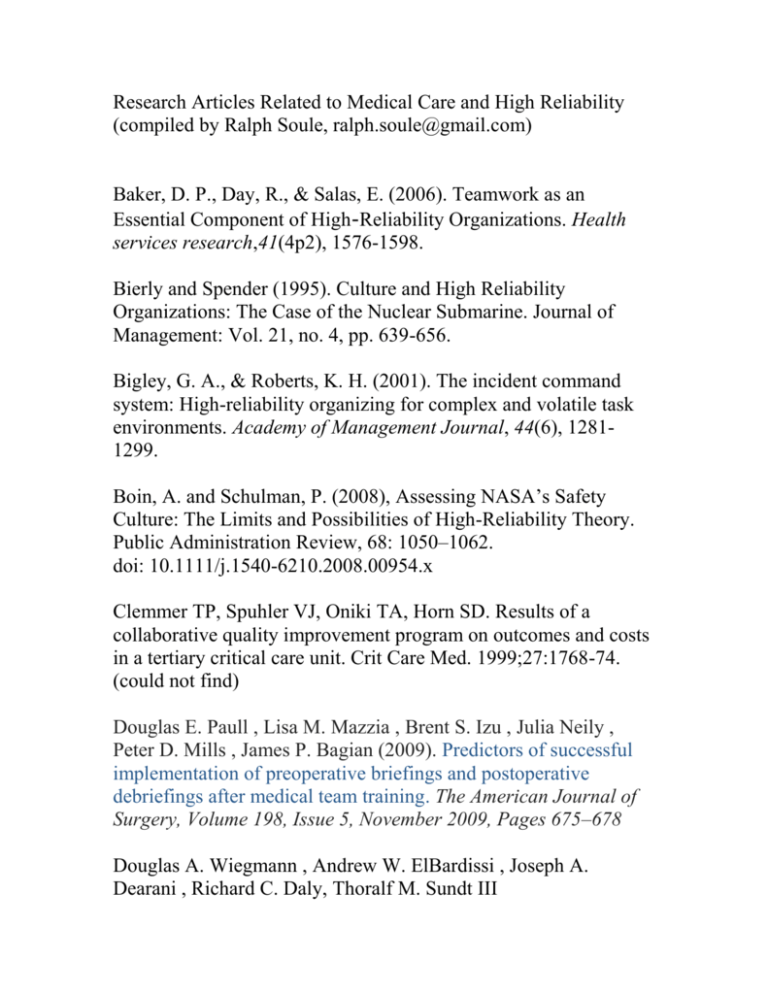
Research Articles Related to Medical Care and High Reliability (compiled by Ralph Soule, ralph.soule@gmail.com) Baker, D. P., Day, R., & Salas, E. (2006). Teamwork as an Essential Component of High‐Reliability Organizations. Health services research,41(4p2), 1576-1598. Bierly and Spender (1995). Culture and High Reliability Organizations: The Case of the Nuclear Submarine. Journal of Management: Vol. 21, no. 4, pp. 639-656. Bigley, G. A., & Roberts, K. H. (2001). The incident command system: High-reliability organizing for complex and volatile task environments. Academy of Management Journal, 44(6), 12811299. Boin, A. and Schulman, P. (2008), Assessing NASA’s Safety Culture: The Limits and Possibilities of High-Reliability Theory. Public Administration Review, 68: 1050–1062. doi: 10.1111/j.1540-6210.2008.00954.x Clemmer TP, Spuhler VJ, Oniki TA, Horn SD. Results of a collaborative quality improvement program on outcomes and costs in a tertiary critical care unit. Crit Care Med. 1999;27:1768-74. (could not find) Douglas E. Paull , Lisa M. Mazzia , Brent S. Izu , Julia Neily , Peter D. Mills , James P. Bagian (2009). Predictors of successful implementation of preoperative briefings and postoperative debriefings after medical team training. The American Journal of Surgery, Volume 198, Issue 5, November 2009, Pages 675–678 Douglas A. Wiegmann , Andrew W. ElBardissi , Joseph A. Dearani , Richard C. Daly, Thoralf M. Sundt III Research Articles Related to Medical Care and High Reliability Disruptions in surgical flow and their relationship to surgical errors: An exploratory investigation Surgery, Volume 142, Issue 5, November 2007, Pages 658–665 Engel, K. G., Rosenthal, M., & Sutcliffe, K. M. (2006). Residents' responses to medical error: coping, learning, and change. Academic Medicine, 81(1), 86-93. Flin, R., O’Connor, P., & Mearns, K. (2002). Crew resource management: improving team work in high reliability industries. Team Performance Management, 8(3/4), 68-78. A.A. Gawande, M.J. Zinner, D.M. Studdert, T.A. Brennan (2003). Analysis of errors reported by surgeons at three teaching hospitals. Surgery, 133 (2003), pp. 614–621. Gittell, J. H., Seidner, R., & Wimbush, J. (2010). A relational model of how high-performance work systems work. Organization Science, 21(2), 490-506. Glasgow, Justin M; Davies, Michael L; Kaboli, Peter J (2012) Findings from a national improvement collaborative: are improvements sustained? BMJ quality & safety vol. 21 (8) p. 6639 Golemboski, K. (2011). Improving patient safety: Lessons from other disciplines. Clinical Laboratory Science, 24(2), 114-9. Retrieved from http://search.proquest.com/docview/890554697?accountid=11243 Henrickson, S. E., Wadhera, R. K., ElBardissi, A. W., Wiegmann, D. A., & Sundt III, T. M. (2009). Development and pilot evaluation of a preoperative briefing protocol for cardiovascular surgery. Journal of the American College of Surgeons, 208(6), 1115-1123. 2 Research Articles Related to Medical Care and High Reliability Vered Holzmann, Shoshana Mischari, Shoshana Goldberg, Amitai Ziv, (2012) "New tools for learning: a case of organizational problem analysis derived from debriefing records in a medical center", Learning Organization, The, Vol. 19 Iss: 2, pp.148 - 162. Holzmann, Mischari, Goldberg, and Ziv (2012). New tools for learning: a case of organizational problem analysis derived from debriefing records in a medical center. The Learning Organization: Volume 19, Issue 2, pp. 148-162. Knox, G. E., Simpson, K. R., & Garite, T. J. (2009). High reliability perinatal units: an approach to the prevention of patient injury and medical malpractice claims. Journal of healthcare risk management, 19(2), 24-32. Knox, G. E., Simpson, K. R. and Townsend, K. E. (2003), High reliability perinatal units: Further observations and a suggested plan for action. J of Healthcare Risk Mgmt, 23: 17–21. doi: 10.1002/jhrm.5600230405 LaPorte, T. R., & Consolini, P. M. (1991). Working in practice but not in theory: theoretical challenges of" high-reliability organizations". Journal of Public Administration Research and Theory: J-PART, 1(1), 19-48. Leape, L. L. (1997), A systems analysis approach to medical error. Journal of Evaluation in Clinical Practice, 3: 213–222. doi: 10.1046/j.1365-2753.1997.00006.x Martin A. Makary, Arnab Mukherjee, J. Bryan Sexton, Dora Syin, Emmanuelle Goodrich, Emily Hartmann, Lisa Rowen, Drew C. Behrens, Michael Marohn, Peter J. Pronovost (2007). Operating Room Briefings and Wrong-Site Surgery. Journal of the American College of Surgeons, Volume 204, Issue 2, 236-243. 3 Research Articles Related to Medical Care and High Reliability Paige, J. T., M.D., Aaron, D. L., M.D., Yang, T., Howell, D. S., Hilton, C. W., M.D., Cohn, I., & Chauvin, Sheila W,M.E.D., P.H.D. (2008). Implementation of a preoperative briefing protocol improves accuracy of teamwork assessment in the operating room. The American Surgeon, 74(9), 817-23. Retrieved from http://search.proquest.com/docview/212826231?accountid=11243 Pisano, G. P., Bohmer, R. M., & Edmondson, A. C. (2001). Organizational differences in rates of learning: Evidence from the adoption of minimally invasive cardiac surgery. Management Science, 47(6), 752-768. Pronovost, P. J., Berenholtz, S. M., Goeschel, C. A., Needham, D. M., Sexton, J. B., Thompson, D. A., ... & Hunt, E. (2006). Creating high reliability in health care organizations. Health services research, 41(4p2), 1599-1617. Rijpma, J. A. (2002). Complexity, tight–coupling and reliability: Connecting normal accidents theory and high reliability theory. Journal of Contingencies and Crisis Management, 5(1), 15-23. Roberts, K. H., & Bea, R. (2001). Must accidents happen? Lessons from high-reliability organizations. The Academy of Management Executive, 15(3), 70-78. van der Schaaf TW. Medical applications of industrial safety science. Quality and Safety in Health Care. 2002;11:206-7. (editorial, not research article) Schenkel, S. (2000), Promoting Patient Safety and Preventing Medical Error in Emergency Departments. Academic Emergency Medicine, 7: 1204–1222. 4 Research Articles Related to Medical Care and High Reliability Spear, S. J., & Schmidhofer, M. (2005). Ambiguity and workarounds as contributors to medical error. Ann Intern Med, 142(8), 627-30. Thompson DN, Wolf GA, Spear SJ. Driving improvement in patient care: lessons from Toyota. J Nurs Adm. 2003;33:585-95. Youngberg, B. J. (2004), Assessing your organization's potential to become a high reliability organization. J of Healthcare Risk Mgmt, 24: 13–20. doi: 10.1002/jhrm.5600240304 Yule, S., Flin, R., Maran, N., Rowley, D., Youngson, G., PatersonBrown, S. (2008). Surgeons’ non-technical skills in the operating room: Reliability testing of the NOTSS behavior rating system. World Journal of Surgery, V32,N4, pp. 548-556 Weick, K. E. (1987). Organizational culture as a source of high reliability. California Management Review, Vol 29, No 2, pp. 112127. Weick, K. E., Sutcliffe, K. M., & Obstfeld, D. (2008). Organizing for high reliability: Processes of collective mindfulness. Crisis management, 3, 81-123. Wiegmann, D., ElBardissi, A., Dearani, J., Daly, R., Sundt III, T (2007). Disruptions in surgical flow and their relationship to surgical errors: An exploratory investigation. Surgery, Volume 142, Issue 5, pp. 658-665. 5




